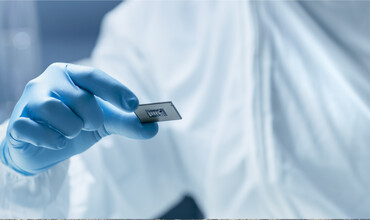As the Cold War heated up and the Titan program was well underway, the Air Force looked to Draper to improve the accuracy of its next-generation Intercontinental Ballistic Missile (ICBM) systems. To meet these expectations, Draper enhanced sensors first developed for the NASA Apollo program to meet the needs for the Minuteman II, Peacekeeper, and Minuteman III weapon systems.
Since then, our team has led or supported several research studies to inform the next-generation ICBM guidance system designs, developing new inertial instrument prototypes, test stations, advanced aiding concepts, and advanced test methodologies.
Contributions to Defense of the Homeland
To defend the United States, Draper has been a longtime supporter of the Missile Defense Agency (MDA), aiding their mission to provide a layered defense system to defend from missile attacks. We have applied our expertise in missile guidance system design and hardening across land-based and sea-based elements of the defense system. Additionally, we are developing novel sensor components which will be integrated into the system in the future.
Guidance Navigation and Control (GN&C) Solutions

Inertial Measurement Unit (IMU)
We develop, build, and test state-of-the-art Inertial Measurement Units (IMUs), providing cutting-edge technology in ballistic missile guidance and navigation. Our IMUs have played crucial roles in supporting a range of systems and missions such as the Agena/CORONA systems, Peacekeeper, Polaris, Poseidon, Trident I, Trident II, the Space Shuttle, and various precision guided munitions and weapons.
Accelerometers
As the need for enhanced guidance and navigation systems continued to evolve, we developed highly precise accelerometers. These advanced sensors take specific force measurements while self-contained in a local inertial frame and require no physical or electromagnetic contact with external references. Our base accelerometers, the Pulse Integrating Pendulous Accelerometer (PIPA) and Pendulous Integrating Gyroscopic Accelerometer (PIGA), have been used in various guidance systems contributing to the success of Air Force and Navy weapon systems.
Gyroscopes
Similar to accelerometers, we developed gyroscopes which are critical components in various applications, from aerospace and defense to robotics and consumer electronics for improved guidance and navigation. Our gyroscopes, such as the radiation-hardened Interferometric Fiber Optic Gyroscope (RH-IFOG), are engineered with precision to assist in stabilizing and orienting vehicles, missiles, and spacecraft, ensuring accurate navigation. Gyroscopes played a pivotal role and contributed to the success of Submarine Inertial Navigation System (SINS), Peacekeeper, Trident I and Trident II programs.
Additional Information
Radiation-Hardened (Rad-Hard) Design
Designing radiation-hardened systems is a niche area that requires specialized expertise due to a scarcity of skilled professionals. We have long maintained this capability for the benefit of our Nation. Components in the systems we design for strategic applications must either possess inherent radiation-hardened properties or be adapted from commercial technology to withstand harsh radiation environments. This adaptation ensures the resilience of materials, inertial sensors, and electronics, such as computers, application-specific integrated circuits (ASICs), memories, and other essential components, to endure radiation effects and quickly recover.
Become a Draper Partner
We want to hear about your challenges and assist you in formulating a solution.
Contact Us

